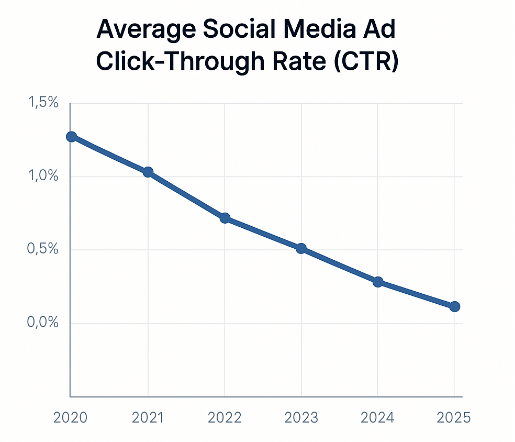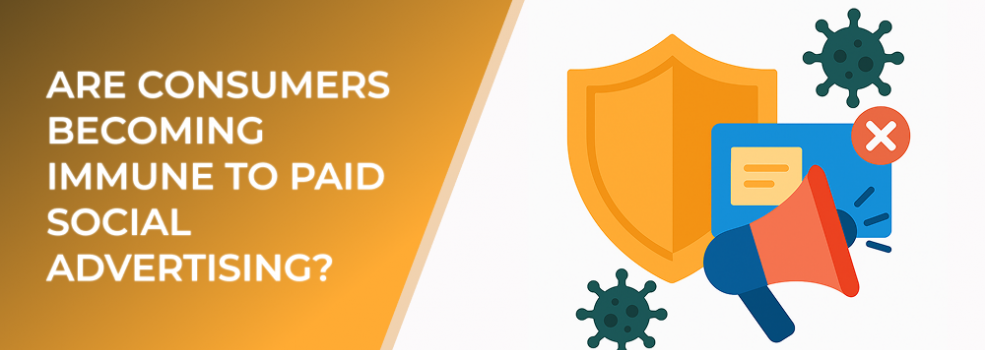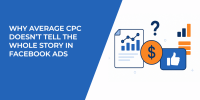Every scroll brings a flood of sponsored content, and users are becoming skilled at tuning it out. According to Statista, the average person is exposed to over 6,000 ads per day across all platforms, with social media taking a major share. This constant exposure reduces attention and emotional impact — a phenomenon known as ad fatigue.
Research from HubSpot found that over 55% of users ignore social ads entirely, while more than 70% say they see too many repetitive ads from the same brands. As a result, traditional paid social campaigns are facing diminishing returns.
Why Audiences Are Tuning Out
1. Repetition and Predictability
Many brands rely on algorithm-optimized creatives that often look and feel the same — polished, product-focused, and predictable. When every brand adopts similar formats and messaging, audiences lose interest.
2. Lack of Authenticity
Today’s users value genuine experiences over corporate polish. Social media was built around community and authenticity, not hard-selling. Ads that feel overly staged or sales-driven create resistance rather than engagement.
3. Increased Control and Awareness
Modern users can easily recognize ad placements and even limit tracking. With privacy updates and increased transparency, audiences are more aware of being targeted — making them more cautious and skeptical of paid promotions.
The Rise of Ad Fatigue in Performance Metrics
Signs of this shift are visible in campaign data. Across industries, average click-through rates (CTR) for Facebook and Instagram ads dropped by 20% between 2022 and 2024, according to Wordstream. Cost-per-click (CPC) is increasing while engagement metrics are stagnating — a clear sign that users are becoming harder to reach with traditional formats.

Trend: Average social media ad click-through rates (CTR) decline from 2020 to 2025
Even Meta’s algorithmic improvements, like Advantage+ campaigns, can’t fully offset audience desensitization. The platform rewards ad freshness and creative variety, but many advertisers struggle to keep up with the pace required to stay relevant.
How Brands Can Break Through the Noise
If consumers are tuning out ads, it doesn’t mean paid social is dead — it means it’s evolving. Here’s how brands can adapt:
1. Prioritize Authentic and UGC-Style Content
Ads that look native to the platform perform significantly better. According to Meta data, UGC-based ads can deliver up to 30% higher engagement rates compared to studio-shot creatives. Use customer videos, testimonials, or influencer partnerships to rebuild trust and relatability.
2. Emphasize Storytelling Over Selling
Narrative-driven ads — showing how a product fits into real life rather than just listing features — help rekindle emotional engagement. Brands that humanize their messaging create stronger connections and longer attention spans.
3. Diversify Ad Formats
Instead of relying solely on feed placements, explore Stories, Reels, and interactive formats like polls or quizzes. Diversifying ad types can reduce fatigue and increase touchpoints throughout the funnel.
4. Refresh Creatives Frequently
Even the best-performing ads lose effectiveness over time. Testing new visuals, hooks, and angles every two to three weeks keeps engagement consistent and prevents audience burnout.
5. Focus on Value, Not Just Promotion
Ads that educate, entertain, or offer insights outperform those that only sell. Providing value makes users more receptive to your brand over time.
What the Future Holds for Paid Social
Paid social isn’t disappearing — it’s transforming into a more user-centered ecosystem. As artificial intelligence and personalization improve, brands will rely less on broad audience targeting and more on contextual relevance. Ads will need to blend seamlessly with user experiences, offering relevance and authenticity rather than interruption.
In fact, Meta’s internal research shows that ads personalized to user intent drive 40% higher conversion rates than generic placements. The challenge for marketers will be to balance automation with human creativity — ensuring campaigns remain both scalable and emotionally engaging.
Final Thoughts
Consumers aren’t rejecting ads altogether — they’re rejecting bad ones. Overly polished, irrelevant, or repetitive creatives simply no longer work. The future of paid social belongs to brands that embrace authenticity, creative diversity, and a more human approach to advertising.
By focusing on storytelling, user-generated content, and value-driven strategies, marketers can overcome ad fatigue and re-engage audiences that have grown immune to traditional campaigns.

